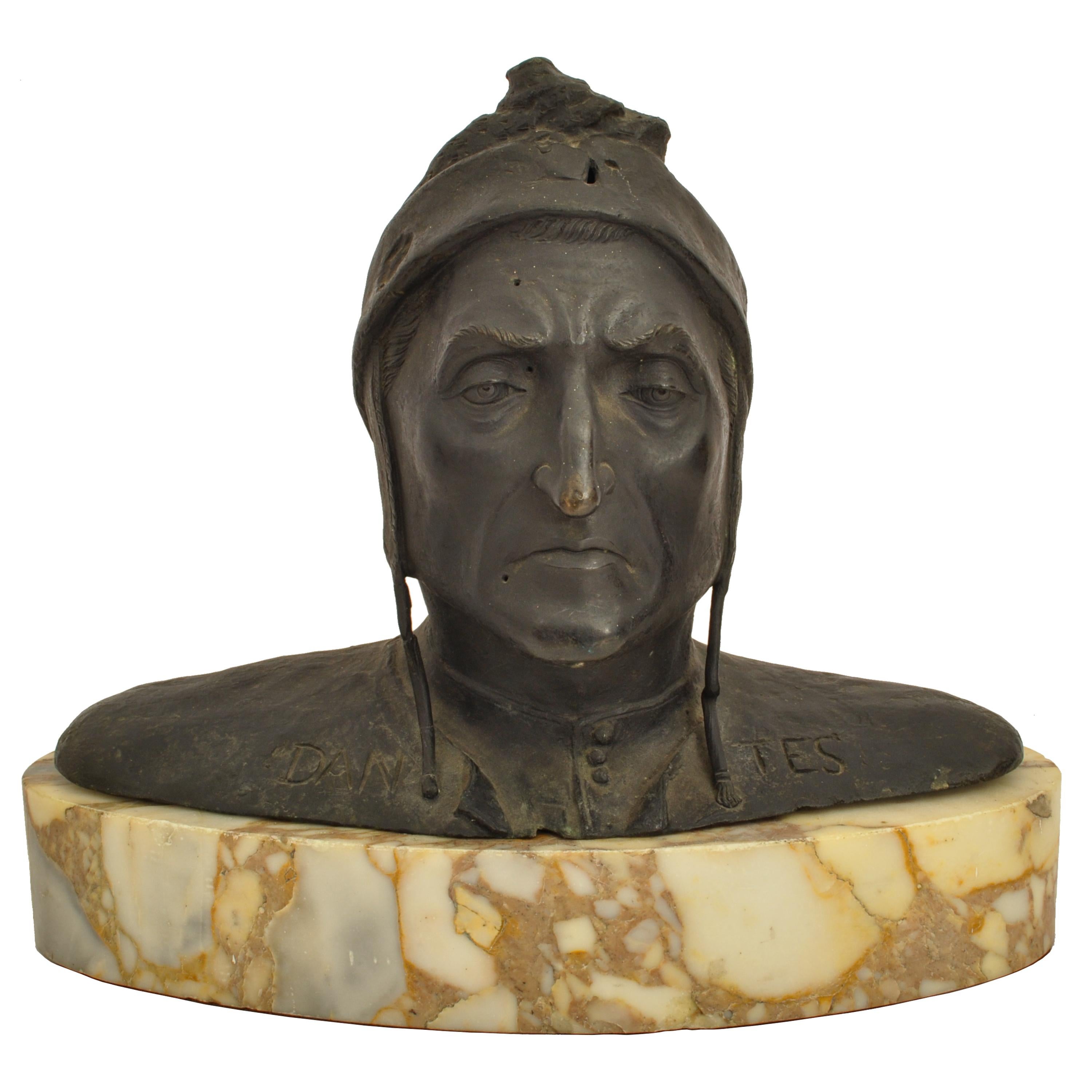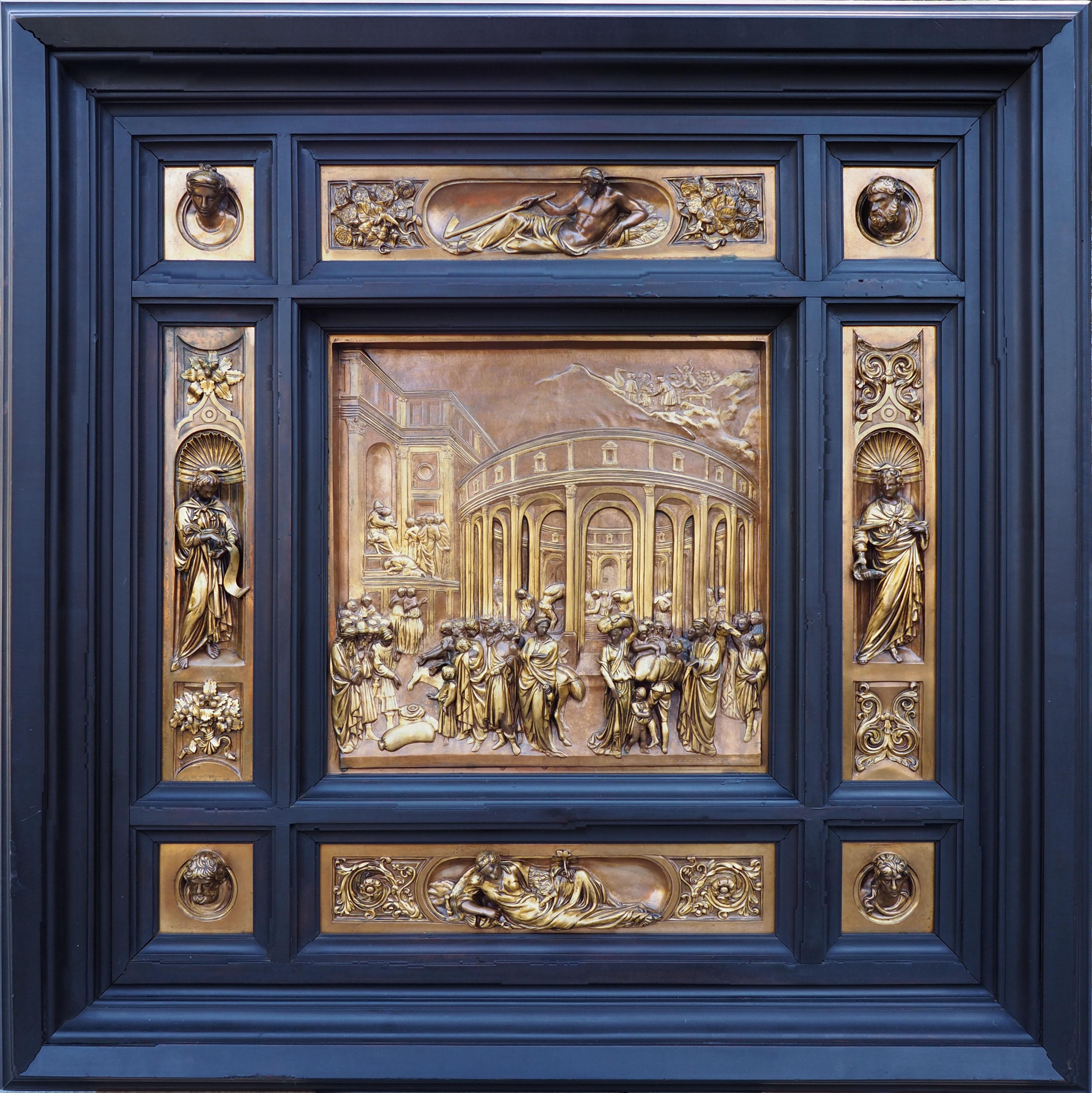Items Similar to Saint Michel et le Dragon
Want more images or videos?
Request additional images or videos from the seller
Emmanuel FremietSaint Michel et le Dragon1879
1879
About the Item
Emmanuel Fremiet, 1824-1910
French
Saint-Michel et le Dragon
Signed “E. Fremiet”, Barbedienne Foundry
23 5/8" high x 5 1/2" wide
FREMIET Emmanuel: Born December 6, 1824 in Paris, died September 10, 1910 in Paris. French artist.
Sculptor of history, mythological compositions, religious scenes, allegorical subjects, busts, animals, engraver, draftsman.
Emmanuel Fremiet was best known for his sculptures; his drawings are generally ignored. He made plaster or bronze, many studies of animals, scenes inspired by the work of Darwin, the life of the first hominids or prehistoric animals.
His works reveal his sharp sense of observation, which is a reflection of his scientific studies; he learnt the truth of bodies.
- Creator:Emmanuel Fremiet (1824-1910, French)
- Creation Year:1879
- Dimensions:Height: 23.63 in (60 cm)Width: 5.52 in (14 cm)
- Medium:
- Period:
- Condition:
- Gallery Location:Paris, FR
- Reference Number:
Emmanuel Fremiet
Emmanuel Frémiet was born in Paris, France in 1824 and was brought into an upper middle-class family that had very close ties to the world of art. His family was filled with great artists and this included his Cousin Sophie who married a famous sculptor called Francois Rude. Emmanuel’s mother was also an accomplished artist who constantly encouraged him and brought him up into the world of art. At the age of five, he was already was receiving formal training in art in a private school. The start at a young age meant he was able to be accepted at the spectacular Ecole des Arts Decoratifs School at the age of sixteen. Throughout this period he learned everything he needed to then become employed by Werner as his head lithographer within a year, whose duties were to prepare drawings of both animals and men. After a long period of convincing by Sophie and Emmanuel, Francois Rude took Emmanuel as a pupil in his studio to further his learning in modeling and sculpture work. Throughout his young life, he spent a lot of time in zoological gardens and participated in dissections of any animals which had passed away during this time. By the age of seven, he had been exposed to a wide range of different wild animals. To further Emmanuel’s path in art, he was appointed the successor of Antoine Louis Barye as Professor of Drawing after Antoine’s death in 1875. With this new position and like many other great sculptors, he spent a lot of time studying and drawing at the morgue and even went to various embalmers across Paris. This was all of his training to give him the exact measurements and to be able to reproduce the muscle and bone structure of the many men and animals that he witnessed. His first sculpture was exhibited in the Paris Salon in 1843 when he was nineteen and he continued to exhibit his magnificent sculptures for the rest of his life at the Salon. He was even awarded various medals and awards from many of his pieces. As he began with the bronze sculptures, he made many small animal bronzes with very fine detail which are nowadays highly sought after by collectors and museums alike. There were many sculptors during this time that crafted pieces in which showed a cruel nature, but Emmanuel was known for the soft and gentle pieces of work which often were amusing. At the age of twenty-five, he was to receive more commissions than any other sculptor before or during his time. It became near impossible to be able to walk the streets without seeing one of Emmanuel’s many smaller bronze sculptures. This amazing sculptor continued crafting works, but also proceeded to train new sculptors, taking on near twenty pupils each time. Unfortunately, this great sculptor passed away in 1910.
About the Seller
5.0
Recognized Seller
These prestigious sellers are industry leaders and represent the highest echelon for item quality and design.
Established in 1969
1stDibs seller since 2017
16 sales on 1stDibs
Typical response time: 1 hour
- ShippingRetrieving quote...Ships From: Paris, France
- Return PolicyThis item cannot be returned.
More From This SellerView All
- Lion HeadBy Bernard & Arnaud BessoudLocated in Paris, FRBernard & Arnaud Bessoud, 1946 & 1971 French "Lion Head", Bronze with brown patina Foundry Chapon Signed on the base and numbered 14/30 Certificate from t...Category
20th Century Figurative Sculptures
MaterialsBronze
- YterbineLocated in Paris, FRDominique Pollès, 1945, French Yterbine, 1998 Bronze with pink platinium patina Signed, dated and numbered 4/4 Certificate by the Artist Dimension...Category
Late 20th Century Figurative Sculptures
MaterialsBronze
- Serre livres aux MaraboutsBy Marcel-André BouraineLocated in Paris, FRMarcel Bouraine 1886-1948 Serre livres aux Marabouts Bronze with silver patina, chryselephantine Signed on the base 9" high, 3 1/2" wide, 2 1/5" depth ...Category
20th Century Figurative Sculptures
MaterialsBronze
- Paire de Serre-livres aux ElephantsBy Ary BitterLocated in Paris, FRAry Bitter 1883-1942 French Paire de Serre-livres aux Elephants (Elephants' Book-Ends) Bronze with green-brown patina Tusks are made of horn Susse foundry Signed Dimensions: 8...Category
Early 19th Century Figurative Sculptures
MaterialsBronze
- Entrance of General Bonaparte in Cairo, 1798By Jean-Léon GérômeLocated in Paris, FRJean-Léon Gérôme, (1824-1904) "Entrance of General Bonaparte in Cairo, 1798" Bronze with medal patina Signed on the base “GEROME” and on the back part “SIOT Fondeur Paris” Dimensi...Category
19th Century Academic Figurative Sculptures
MaterialsBronze
- Three Walking Black Panthers, circa 1930By Maurice ProstLocated in Paris, FRMaurice Prost, 1894-1967, French Three Walking Black Panthers, circa 1930 Bronzes with black patina Signed on the marble M. PROST and “Susse Frères Editeurs, Paris” Certificate by M...Category
20th Century Art Deco Figurative Sculptures
MaterialsBronze
You May Also Like
- Surreal Figurative Sculpture, "Lovers"Located in San Diego, CAThis is a one of a kind original bronze surrealist figurative sculpture by San Diego artist, Debbie Korbel. Its dimensions are 41" x 42" x 34". A certifi...Category
2010s Surrealist Figurative Sculptures
MaterialsBronze
- Antique Italian Grand Tour Bronze Marble Bust Sculpture Dante Alighieri 1880Located in Portland, ORA good antique Italian Grand Tour Bronze and marble bust of Dante Alighieri, circa 1880. The bronze is most likely Florentine and mod...Category
Late 19th Century Italian School Figurative Sculptures
MaterialsMarble, Bronze
- WHITE HINGED POEM DRESS,By Lesley DillLocated in New York, NYLESLEY DILL WHITE HINGED POEM DRESS, 1994 patinated bronze 55 x 37 x 30 in. 139.7 x 94 x 76.2 cm. Edition of 4Category
1990s Contemporary Figurative Sculptures
MaterialsBronze
- Growing in a Fragmented LandscapeBy Jennyfer StratmanLocated in Los Angeles, CAThere is a metaphorical interplay between the natural imagery international artist, Jennyfer Stratman, uses and its multiple meanings. While the human figure features strongly, it is...Category
21st Century and Contemporary Contemporary Figurative Sculptures
MaterialsMetal, Bronze, Enamel, Steel, Copper
- Cefiro - Renaissance Inspired Bronze Sculpture of an Acrobat set on Tall StandBy Jesus Curia PerezLocated in Chicago, ILCefiro is derived from the Spanish word for Zephyr, meaning a soft gentle wind which brings spring to the Mediterranean. The word also depicts beauty and playfulness. This figure p...Category
21st Century and Contemporary Contemporary Figurative Sculptures
MaterialsBronze, Steel
- The Story of Joseph from the Second Baptistery Doors, Florence (“The Gates of PaBy Ferdinand BarbedienneLocated in New York, NYFerdinand Barbedienne (Saint-Martin-de-Fresnay 1810 – 1892 Paris) after Lorenzo Ghiberti (Florence, 1378 – 1455) Signed at the lower right of the principal relief: F. BARBEDIENNE Provenance: Private Collection, USA. Barbedienne’s “Gates of Paradise” reliefs are one of the triumphs of nineteenth-century bronze casting and patination. The nine panels that comprise our example are half-size reductions of the famous originals by Lorenzo Ghiberti, made for the Baptistery of Florence and now housed in the Museo del Opera del Duomo. Mounted in an impressive, mullioned frame surround, our work is an exceptional exemplar of the Renaissance Revival, the broadly influential style and movement that infused architecture, design, and artistic culture in the latter half of the nineteenth century. The central scene, The Story of Joseph, is perhaps the most celebrated of the entire series depicting as it does seven episodes from the Biblical narrative integrated into a single composition: Joseph cast by his brethren into the well, Joseph sold to the merchants, the merchants delivering Joseph to the pharaoh, Joseph interpreting the pharaoh’s dream, the pharaoh paying him honor, Jacob sending his sons to Egypt, and Joseph recognizes his brothers and returns home. The surrounding reliefs—two vertical figures in niches, two recumbent figures, and four portrait heads in roundels—are as well faithful reductions of Ghiberti’s original bronzes on other parts of the doors. The maker of these casts was the renowned 19th-century French fondeur Ferdinand Barbedienne. Gary Radke has recently written of this great enterprise: “The Parisian bronze caster Ferdinand Barbedienne began making half-sized copies of ancient and Renaissance sculpture in the 1830s. His firm benefitted enormously from the collaboration of Achille Collas, whom Meredith Shedd has shown was one of numerous pioneers in the mechanical reproduction of sculpture. Their competitors largely devoted themselves to reproducing relief sculpture, but Collas devised a process for creating fully three-dimensional copies. A tracing needle, powered by a treadle, moved over the surface of a full-sized plaster cast or bronze of the original and triggered a complementary action in a cutting stylus set over a soft plaster blank…He signed an exclusive contract with Barbedienne on November 29, 1838, and won medals for his inventions in 1839 and 1844. Barbedienne’s half-sized copies of the Gates of Paradise were famous not only for their fidelity to the original, but also for the way their gilding…suggested the glimmering surface that was hidden under centuries of dirt. Some critics even saw Collas’s and Barbedienne’s work as ‘philanthropic, an exemplary adaptation of industry to the requirements of art, the artist, the workers, and the public alike.’ At 25,000 francs, Collas’s and Barbedienne’s reduction of the Gates of Paradise was singularly more expensive than any other item for sale in their shop. All the reliefs, individual statuettes, and busts were cast separately and could be purchased either by the piece or as an ensemble. Fittingly, Barbedienne’s accomplishment earned him the Grand Prix at the 1878 Paris Exposition Universelle, along with numerous other medals.” Three complete examples of the Barbedienne-Ghiberti doors are known. One, first installed in a chapel in the Villa Demidoff of San Donato near Pratolino, was later acquired by William Vanderbilt...Category
Late 19th Century Figurative Sculptures
MaterialsBronze
Recently Viewed
View AllMore Ways To Browse
French Saints
Et Antique
Antique Dragons
Antique Dragon
Dragon Antique
Saint Bronze
French Dragon
Dragon France
Bronze Dragon
Michel Bronze
Dragon Sculpture
Antique Bronze Dragon
French Plaster Bust
Plaster Bust France
Bronze Allegorical Sculpture
19th Plaster Busts
19th Century Plaster Bust
Religious Saint Sculpture





